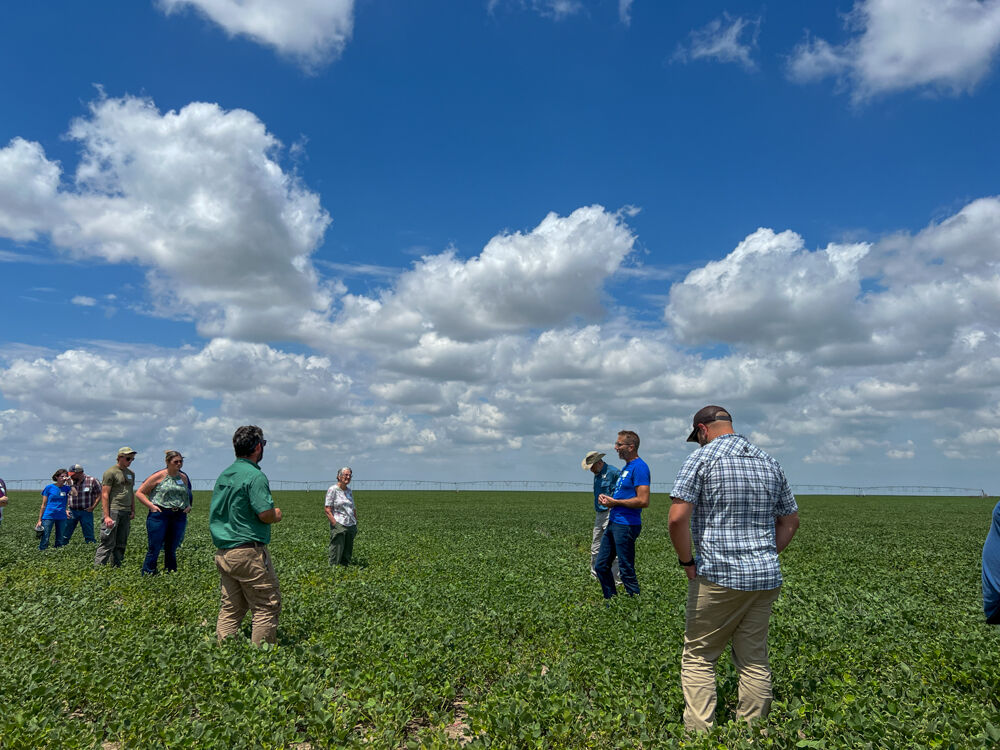A recent bus tour gave participants access to conservation and water stakeholders, as well as a pair of progressive producers located in the Arkansas River Basin.
Speakers on the tour that departed from Dodge City, Kansas, and traveled southwest through Ensign and Montezuma then on to Garden City and they discussed irrigation technology, soil health and playas—all of which help conserve water in the area.
Ducks Unlimited biologist Abe Lollar detailed the first stops on the tour featuring playa restoration work. Playas are found in six states in the High Plains—Texas, Oklahoma, New Mexico, Kansas, Colorado, and Nebraska. Lollar said Gray County, Kansas, is a very unique area with “a ton of playa restoration work that’s happened throughout the years.”
Productive from a wildlife standpoint, playas host more than 600 species of plants, amphibians, birds, mammals and reptiles that use the landscape features for at least one part of their lifecycle.
Why are the playas important? Because they’re the No. 1 source of recharge to the Ogallala Aquifer.
“We’re talking about how we’re using water in western Kansas and a big part of this tour is efficiencies of irrigation use,” he said. “But there’s also another side of that coin of getting water back into the aquifer. And that’s where these things are important.”
On average, a 4-acre playa can recharge the aquifer about 1-acre-foot per year.
“So, if we restored every single playa in western Kansas, we’re looking at about 20,000-acre feet annually—but that’s a little over 6.6 billion gallons of water annually going back into the ground just by restoring a few of these landscapes or all the landscape features that are dotted across western Kansas,” Lollar said. “The bad part of that story is there’s only about 10% of these things that are functioning properly.”
Realistically there’s only about 660 million gallons of water going back into the aquifer from the restored regions. In Gray County, attendees were able to see pooled up areas either in farm fields or pasturelands.
The site the tour visited was in a program called Wetlands Reserve Easement program through the Natural Resources Conservation Service and is in an easement perpetually.
Irrigation technologies
Kansas Water Office technology projects manager Weston McCary oversees the Water Innovation Systems and Education program. WISE is the second phase of the original legacy water technology farm programs launched in 2016.
“Initially, the legacy tech farm program focused on irrigation technologies,” he said. “We’re trying to find different types of efficiencies that producers could implement in their fields.”
At the time, the vision was to have demonstration farms that allowed farmers to choose whatever technologies, practices and combinations of tools to have healthy soil and conserve water.
“We’re trying to figure out which things would be cost prohibitive and which things actually resulted in measurable water conservation,” McCary said.
McCary said they wanted to create a program on the state level that’s easy enough to get involved with and not a cost share program.
One goal he wanted to add to the WISE program was water reclamation. McCary said this concern first came from the feed yard and dairy sectors. They not only had cattle consuming 10 to 14 gallons of water per head per day in their operations but also all the water that went into the crop production for the feed. They also had concerns about water overflowing out of tanks or into lagoons and worked to develop tracking mechanisms for this issue.
McCary is pleased they’re able to recognize the conservation going on in the feedlots and dairies, but it’s happening in the crop sector too. With AI technology there’s jobs that humans don’t need to do, such as adjusting water pumps or regulating flow. Autonomous pivots at one of the WISE sites are taking advantage of this new technology.
The pivot can make decisions a lot faster and better than a hired hand or producer can who has 50 or 60 other pivots to manage.
Sign up for HPJ Insights
Our weekly newsletter delivers the latest news straight to your inbox including breaking news, our exclusive columns and much more.
“We’re noticing that we can put in all of our best of intents into some of this technology and let it do its work,” McCary said. “It’ll carry out what we tell it to do, where it’s intended to do, while we go do other things. Because we’re finding that when we put a metric to it it’s about 16% to 19% water savings just in letting an automated system run versus a manual system.”
The added technology also needs internet to run, and in recent years McCary said fiber infrastructure has been added, but it’s still not complete. When asked what the biggest hurdle for production agriculture in western Kansas, his answer every time is rural broadband and ongoing producer education.
“But the big thing is that you have to have an attitude,” he said. “We have to get to a point where we’re working on trying to help producers have an attitude that’s willing to buck their traditions or how things were given to them.”
When it comes to soil and water and some people believe technology is the answer, but in reality, it’s not everything.
“If our soil and our water is not in good shape on a field, the technology is going to tell us,” he said. “So tech is not an answer. It’s not a silver bullet. It’s a tool.”
Kylene Scott can be reached at 620-227-1804 or [email protected].




